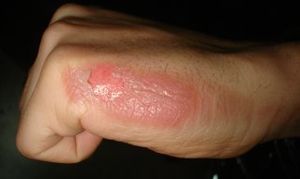ਸਾੜ-ਸੋਜ਼
| ਸਾੜ-ਸੋਜ਼ | |
|---|---|
 | |
| ਹਥ ਤੇ ਦੂਜੀ-ਡਿਗਰੀ ਦਾ ਸਾੜ | |
| ਵਿਸ਼ਸਤਾ | critical care medicine |
| ਲੱਛਣ | ਸਤਹੀ: ਛਾਲੇ ਨਹੀਂ ਬਣਦੇ ਪਰ ਲਾਲ ਵਿਖਾਈ ਦਿੰਦੇ ਹਨ।[1] ਅੰਸ਼ਕ-ਮੋਟਾਈ: ਛਾਲੇ ਅਤੇ ਜਲਣ[1] ਪੂਰੀ ਮੋਟਾਈ ਦੇ ਸਾੜ: ਅਕੜਾ ਪਰ ਕੋਈ ਦਰਦ ਨਹੀਂ[1] |
| ਗੁਝਲਤਾ | ਜਖ਼ਮ[2] |
| ਸਮਾਂ | ਦਿਨਾਂ ਤੋਂ ਹਫ਼ਤਿਆਂ ਤੀਕਰ[1] |
| ਕਿਸਮ | ਸਤਹੀ, ਅੰਸ਼ਕ-ਮੋਟਾਈ, ਪੂਰੀ ਮੋਟਾਈ[1] |
| ਕਾਰਨ | ਗਰਮੀ, ਠੰਡ, ਬਿਜਲੀ, ਰਸਾਇਣ, ਰਗੜ, ਰੇਡੀਏਸ਼ਨ[3] |
| ਜ਼ੋਖਮ ਕਾਰਕ | Open cooking fires, unsafe cook stoves, smoking, alcoholism, dangerous work environment[4] |
| ਇਲਾਜ | ਗੰਭੀਰਤਾ ਤੇ ਨਿਰਭਰ ਕਰਦਾ ਹੈ।[1] |
| ਦਵਾਈ | Pain medication, intravenous fluids, tetanus toxoid[1] |
| ਅਵਿਰਤੀ | 67 million (2015)[5] |
| ਮੌਤਾਂ | 176,000 (2015)[6] |
ਸਾੜ-ਸੋਜ਼ ਸਰੀਰ ਦੇ ਕਿਸੇ ਇੱਕ ਜਾਂ ਅਨੇਕ ਅੰਗਾਂ ਤੇ ਇੱਕ ਪ੍ਰਕਾਰ ਦਾ ਜਖਮ ਹੈ ਜੋ ਗਰਮੀ, ਠੰਡ, ਬਿਜਲੀ, ਰਸਾਇਣ, ਰਗੜ, ਰੇਡੀਏਸ਼ਨ ਆਦਿ ਨਾਲ ਹੋ ਸਕਦਾ ਹੈ।[3] ਬਹੁਤ ਠੰਡੀਆਂ ਚੀਜਾਂ ਦੇ ਸੰਪਰਕ ਵਿੱਚ ਆਉਣ ਨਾਲ ਵੀ ਸਰੀਰ ਸੜ ਸਕਦਾ ਹੈ ਜਿਸਨੂੰ ਸੀਤ-ਸਾੜ (ਕੋਲਡ ਬਰਨ) ਕਹਿੰਦੇ ਹਨ। ਬਹੁਤੇ ਸਾੜ ਗਰਮ ਤਰਲ, ਠੋਸ ਪਦਾਰਥਾਂ, ਜਾਂ ਅੱਗ ਦੇ ਸੇਕ ਨਾਲ ਹੁੰਦੇ ਹਨ। [7] ਹਾਲਾਂਕਿ ਦਰਾਂ ਮਰਦਾਂ ਅਤੇ ਔਰਤਾਂ ਲਈ ਸਮਾਨ ਹੁੰਦੀਆਂ ਹਨ ਪਰ ਮੂਲ ਕਰਨ ਅਕਸਰ ਵੱਖ ਵੱਖ ਹੁੰਦੇ ਹਨ। ਕੁਝ ਇਲਾਕਿਆਂ ਵਿੱਚ ਔਰਤਾਂ ਵਿਚ, ਖਤਰਨਾਕ ਖੁੱਲ੍ਹੇ ਚੁਲ੍ਹਿਆਂ ਜਾਂ ਅਸੁਰੱਖਿਅਤ ਕੁੱਕ ਸਟੋਵਾਂ ਨਾਲ ਸੰਬੰਧਤ ਹੈ। ਮਰਦਾਂ ਵਿਚ, ਜੋਖਮ ਕੰਮ ਦੇ ਮਾਹੌਲ ਨਾਲ ਜੁੜਿਆ ਹੁੰਦਾ ਹੈ। ਸ਼ਰਾਬ ਅਤੇ ਸਿਗਰਟ ਸ਼ਰਾਬ ਅਤੇ ਤੰਬਾਕੂਨੋਸ਼ੀ ਹੋਰ ਜੋਖਮ ਦੇ ਕਾਰਕ ਹਨ ਸਵੈ ਨੁਕਸਾਨ ਜਾਂ ਲੋਕਾਂ ਦੇ ਆਪਸੀ ਹਿੰਸਾ ਦੇ ਨਤੀਜੇ ਵਜੋਂ ਬਰਨ ਹੋ ਸਕਦਾ ਹੈ।
ਸਿਰਫ ਸਤਹੀ ਚਮੜੀ ਦੀਆਂ ਪਰਤਾਂ ਨੂੰ ਪ੍ਰਭਾਵਿਤ ਕਰਨ ਵਾਲੇ ਸਾੜਿਆਂ ਨੂੰ ਸਤਹੀ ਜਾਂ ਪਹਿਲੀ-ਡਿਗਰੀ ਦੇ ਸਾੜੇ ਕਿਹਾ ਜਾਂਦਾ ਹੈ ਉਹ ਛਾਲੇ ਨਹੀਂ ਬਣਦੇ ਪਰ ਲਾਲ ਵਿਖਾਈ ਦਿੰਦੇ ਹਨ ਅਤੇ ਆਮ ਤੌਰ ਤੇ ਤਿੰਨ ਦਿਨ ਰਹਿੰਦੇ ਹਨ।[8] ਜਦੋਂ ਸੱਟ ਤਵਚਾ ਦੀ ਕੁਝ ਹੇਠਲੀ ਪਰਤ ਵਿੱਚ ਫੈਲਦੀ ਹੈ, ਇਹ ਇੱਕ ਅੰਸ਼ਕ-ਮੋਟਾਈ ਦਾ ਜਾਂ ਦੂਜੀ-ਡਿਗਰੀ ਦਾ ਸਾੜ ਹੁੰਦਾ ਹੈ। ਛਾਲੇ ਅਕਸਰ ਮੌਜੂਦ ਹੁੰਦੇ ਹਨ ਅਤੇ ਉਹ ਅਕਸਰ ਬਹੁਤ ਹੀ ਦਰਦਨਾਕ ਹੁੰਦੇ ਹਨ। ਤੰਦਰੁਸਤੀ ਲਈ ਅੱਠ ਹਫਤਿਆਂ ਤੱਕ ਦੀ ਜ਼ਰੂਰਤ ਹੋ ਸਕਦੀ ਹੈ ਅਤੇ ਜਰਾ ਹੋ ਸਕਦੀ ਹੈ। ਪੂਰੀ ਮੋਟਾਈ ਦੇ ਜਾਂ ਤੀਜੀ-ਡਿਗਰੀ ਦੇ ਸਾੜ ਵਿਚ, ਸੱਟ ਚਮੜੀ ਦੀਆਂ ਸਾਰੀਆਂ ਪਰਤਾਂ ਤਕ ਫੈਲ ਜਾਂਦੀ ਹੈ। ਅਕਸਰ ਕੋਈ ਦਰਦ ਨਹੀਂ ਹੁੰਦਾ ਹੈ ਅਤੇ ਜਲਣ ਵਾਲਾ ਖੇਤਰ ਆਕੜ ਜਾਂਦਾ ਹੈ। ਤੰਦਰੁਸਤੀ ਵਿਸ਼ੇਸ਼ ਤੌਰ 'ਤੇ ਆਪਣੇ ਆਪ ਨਹੀਂ ਹੁੰਦੀ। ਇੱਕ ਚੌਥੇ ਡਿਗਰੀ ਵਾਲੇ ਸਾੜ ਵਿੱਚ ਡੂੰਘੇ ਟਿਸ਼ੂਆਂ ਜਿਵੇਂ ਕਿ ਮਾਸਪੇਸ਼ੀਆਂ, ਨਸਾਂ ਜਾਂ ਹੱਡੀਆਂ ਨੂੰ ਸੱਟ ਲੱਗਦੀ ਹੈ।[1] ਸਾੜ ਦਾ ਰੰਗ ਅਕਸਰ ਕਾਲਾ ਹੁੰਦਾ ਹੈ ਅਤੇ ਅਕਸਰ ਸੜ ਗਏ ਹਿੱਸੇ ਦੀ ਹਾਨੀ ਹੋ ਜਾਂਦੀ ਹੈ।[9]
ਰੋਕਥਾਮ ਅਤੇ ਪ੍ਰਬੰਧਨ
ਸਾੜ ਆਮ ਤੌਰ ਤੇ ਰੋਕੇ ਜਾ ਸਕਦੇ ਹੁੰਦੇ ਹਨ।[4] Treatment depends on the severity of the burn.[1] ਸਤਹੀ ਜ਼ਖ਼ਮਾਂ ਨੂੰ ਸਧਾਰਨ ਦਰਦ ਦੀਆਂ ਦਵਾਈਆਂ ਨਾਲੋਂ ਥੋੜ੍ਹਾ ਹੋਰ ਤਿੱਖੀਆਂ ਦਵਾਈਆਂ ਨਾਲ ਸੰਭਾਲਿਆ ਜਾ ਸਕਦਾ ਹੈ], ਜਦੋਂ ਕਿ ਵੱਡੇ ਸਾੜ ਲਈ ਵਿਸ਼ੇਸ਼ ਬਰਨ ਸੈਂਟਰ ਦੇ ਲੰਬੇ ਇਲਾਜ ਦੀ ਲੋੜ ਹੋ ਸਕਦੀ ਹੈ।[1] Cooling with tap water may help pain and decrease damage; however, prolonged cooling may result in low body temperature.[1][8] ਅੰਸ਼ਕ-ਮੋਟਾਈ ਦੇ ਸਾੜ ਲਈ ਸਾਬਣ ਅਤੇ ਪਾਣੀ ਨਾਲ ਸਫਾਈ ਅਤੇ ਬਾਅਦ ਨੂੰ ਪੱਟੀਆਂ ਕਰਨ ਦੀ ਲੋੜ ਹੋ ਸਕਦੀ ਹੈ।[1] ਇਹ ਸਪਸ਼ਟ ਨਹੀਂ ਕਿ ਛਾਲਿਆਂ ਦਾ ਪ੍ਰਬੰਧ ਕਿਵੇਂ ਕਰਨਾ ਹੈ, ਪਰ ਇਹ ਸੰਭਵ ਹੈ ਕਿ ਜੇ ਉਹ ਛੋਟੇ ਹੋਣ ਤਾਂ ਉਨ੍ਹਾਂ ਨੂੰ ਨਾ ਛੇੜੋ ਅਤੇ ਜੇ ਉਹ ਵੱਡੇ ਹੋਣ ਤਾਂ ਉਨ੍ਹਾਂ ਦਾ ਪਾਣੀ ਕਢ ਦੇਵੋ।[1] ਪੂਰੀ ਮੋਟਾਈ ਸਾੜ ਲਈ ਆਮ ਤੌਰ 'ਤੇ ਸਰਜੀਕਲ ਇਲਾਜ ਦੀ ਲੋੜ ਹੁੰਦੀ ਹੈ, ਜਿਵੇਂ ਕਿ ਚਮੜੀ ਗ੍ਰਾਫਟਿੰਗ,[1] ਬਹੁਤ ਵਿਆਪਕ ਸਾੜਿਆਂ ਲਈ ਅਕਸਰ ਇਨਟ੍ਰਵੈਨਸ ਤਰਲ ਦੀ ਵੱਡੀ ਮਾਤਰਾ ਵਿੱਚ ਲੋੜ ਹੁੰਦੀ ਹੈ। [8] ਬਰਨ ਦੀਆਂ ਸਭ ਤੋਂ ਆਮ ਉਲਝਣਾਂ ਵਿੱਚ ਇਨਫੈਕਸ਼ਨ ਸ਼ਾਮਲ ਹੁੰਦੀ ਹੈ।[2]
ਹਵਾਲੇ
- ↑ 1.00 1.01 1.02 1.03 1.04 1.05 1.06 1.07 1.08 1.09 1.10 1.11 1.12 1.13 Tintinalli, Judith E. (2010). Emergency Medicine: A Comprehensive Study Guide (Emergency Medicine (Tintinalli)). New York: McGraw-Hill Companies. pp. 1374–1386. ISBN 0-07-148480-9.
- ↑ 2.0 2.1 Herndon D, ed. (2012). "Chapter 3: Epidemiological, Demographic, and Outcome Characteristics of Burn Injury". Total burn care (4th ed.). Edinburgh: Saunders. p. 23. ISBN 978-1-4377-2786-9.
- ↑ 3.0 3.1 Herndon D, ed. (2012). "Chapter 4: Prevention of Burn Injuries". Total burn care (4th ed.). Edinburgh: Saunders. p. 46. ISBN 978-1-4377-2786-9.
- ↑ 4.0 4.1 "Burns". World Health Organization. September 2016. Archived from the original on 21 July 2017. Retrieved 1 August 2017.
{cite web}: Unknown parameter|deadurl=ignored (|url-status=suggested) (help) - ↑ GBD 2015 Disease and Injury Incidence and Prevalence, Collaborators. (8 October 2016). "Global, regional, and national incidence, prevalence, and years lived with disability for 310 diseases and injuries, 1990–2015: a systematic analysis for the Global Burden of Disease Study 2015". Lancet. 388 (10053): 1545–1602. doi:10.1016/S0140-6736(16)31678-6. PMC 5055577. PMID 27733282.
{cite journal}:|first1=has generic name (help)CS1 maint: numeric names: authors list (link) - ↑ GBD 2015 Mortality and Causes of Death, Collaborators. (8 October 2016). "Global, regional, and national life expectancy, all-cause mortality, and cause-specific mortality for 249 causes of death, 1980–2015: a systematic analysis for the Global Burden of Disease Study 2015". Lancet. 388 (10053): 1459–1544. doi:10.1016/S0140-6736(16)31012-1. PMC 5388903. PMID 27733281.
{cite journal}:|first1=has generic name (help)CS1 maint: numeric names: authors list (link) - ↑ "Burns Fact sheet N°365". WHO. April 2014. Archived from the original on 2015-11-10. Retrieved 3 March 2016.
{cite web}: Unknown parameter|dead-url=ignored (|url-status=suggested) (help) - ↑ 8.0 8.1 8.2 Granger, Joyce (Jan 2009). "An Evidence-Based Approach to Pediatric Burns". Pediatric Emergency Medicine Practice. 6 (1). Archived from the original on 17 October 2013.
{cite journal}: Unknown parameter|dead-url=ignored (|url-status=suggested) (help) - ↑ Ferri, Fred F. (2012). Ferri's netter patient advisor (2nd ed.). Philadelphia, PA: Saunders. p. 235. ISBN 9781455728268. Archived from the original on 21 December 2016.
{cite book}: Unknown parameter|dead-url=ignored (|url-status=suggested) (help)